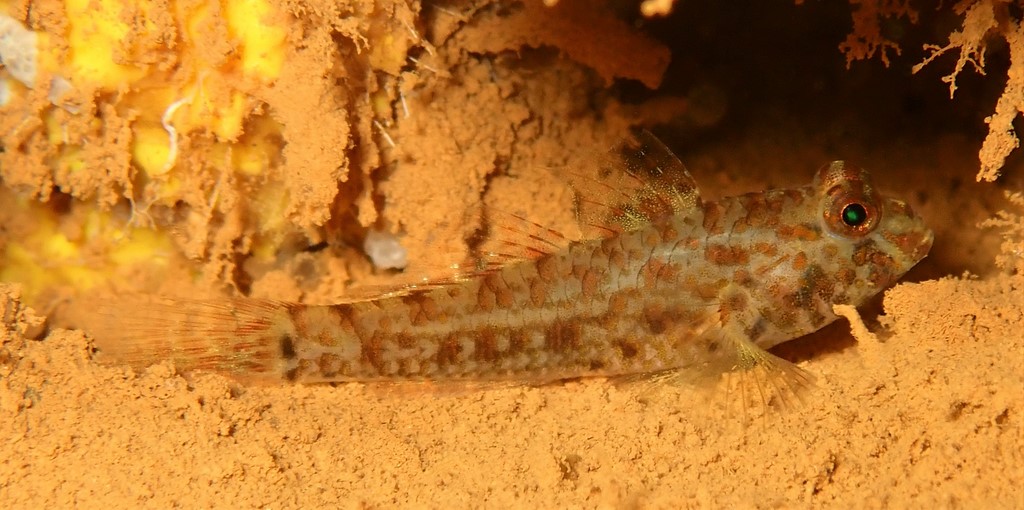ASTERROPTERYX SPINOSA - (GOREN, 1981)
Picture courtesy of: Alain Daoulas
Actinopterygii (Gigaclass) > Actinopteri (Class) > Teleostei (Subclass) > Gobiiformes (Order) > Gobioidei (Suborder) > Gobiidae (Family) > Gobiinae (Subfamily) > Asterropteryx (Genus)
Eyebar spinygoby, Eye-bar rubblegoby, Eyebar spiny goby, Spiny goby, Madara-hoshihaze, マダラホシハゼ, 棘星塘鱧,
Synonymes
Asterropteryx spinosus (Goren, 1981)
Oplopomus spinosus (Goren, 1981)
-------------------------
Description
Dorsal spines (total): 7; Dorsal soft rays (total): 10-11; Anal spine: 1; Anal soft rays: 9-10 (usually: 9); Pectoral fin rays: 17-19; Longitudinal scale series: 21-24; Predorsal scales: 5, reaching to behind eyes; Transverse rows of scales backwards: 7; Ctenoid scales on body, becoming cycloid anterior to pelvic and pectoral fins. Depth of body: 3.7-4.0 in SL. Spines on rear edge of preopercle: 3-7, lowermost often larger than others; Rounded caudal fin; Pelvic fins united medially, disc-like; Fourth dorsal spine, forming long filament in adult. Cheek naked; Opercle with large ctenoid scales; Large spine on rear edge of preopercle, with 2-4 smaller spines above it. Max. length: 4.6 cm SL. Depth range: 1 - 30 m, usually: 3 - 15 m.
Color
Head and body translucent whitish, covered with pale orange blotches and small spots, several small dusky spots along midsides of body; Head with blackish vertical bar from eyes to just below corners of mouth; Blackish oblique blotch or streak behind eyes;A diffuse black spot (about size of pupil) usually present between first and second spines of first dorsal fin; Short dark vertical line at caudal fin base.
Etymology
Asterropteryx: from Greek prefix, a- , an- = not, without, (having) no + from Greek, sterrhos, -a, -on = firm, solid + from Greek, pteryx = fin. Referring to slender and flexible dorsal fin spines.
spinosa: from Latin, spinosa = spiny. Referring to five bony, spine-like projections on preopercle.
Original description: Oplopomus spinosus Goren, 1981 - Type locality: north coast of Maitre Island, New Caledonia, depth 3-5 meters.
Distribution
Indo-West Pacific: Seychelles and Maldives, east to Fiji and Tonga, north to Ryukyu Islands (Japan), south to northern Australia and New Caledonia.
Biology
Prefers clear clean waters on coral reefs. Found on sandy and muddy bottoms of coral rubble.
Last update: 20, October 2024
Actinopterygii (Gigaclass) > Actinopteri (Class) > Teleostei (Subclass) > Gobiiformes (Order) > Gobioidei (Suborder) > Gobiidae (Family) > Gobiinae (Subfamily) > Asterropteryx (Genus)
Eyebar spinygoby, Eye-bar rubblegoby, Eyebar spiny goby, Spiny goby, Madara-hoshihaze, マダラホシハゼ, 棘星塘鱧,
Synonymes
Asterropteryx spinosus (Goren, 1981)
Oplopomus spinosus (Goren, 1981)
-------------------------
Description
Dorsal spines (total): 7; Dorsal soft rays (total): 10-11; Anal spine: 1; Anal soft rays: 9-10 (usually: 9); Pectoral fin rays: 17-19; Longitudinal scale series: 21-24; Predorsal scales: 5, reaching to behind eyes; Transverse rows of scales backwards: 7; Ctenoid scales on body, becoming cycloid anterior to pelvic and pectoral fins. Depth of body: 3.7-4.0 in SL. Spines on rear edge of preopercle: 3-7, lowermost often larger than others; Rounded caudal fin; Pelvic fins united medially, disc-like; Fourth dorsal spine, forming long filament in adult. Cheek naked; Opercle with large ctenoid scales; Large spine on rear edge of preopercle, with 2-4 smaller spines above it. Max. length: 4.6 cm SL. Depth range: 1 - 30 m, usually: 3 - 15 m.
Color
Head and body translucent whitish, covered with pale orange blotches and small spots, several small dusky spots along midsides of body; Head with blackish vertical bar from eyes to just below corners of mouth; Blackish oblique blotch or streak behind eyes;A diffuse black spot (about size of pupil) usually present between first and second spines of first dorsal fin; Short dark vertical line at caudal fin base.
Etymology
Asterropteryx: from Greek prefix, a- , an- = not, without, (having) no + from Greek, sterrhos, -a, -on = firm, solid + from Greek, pteryx = fin. Referring to slender and flexible dorsal fin spines.
spinosa: from Latin, spinosa = spiny. Referring to five bony, spine-like projections on preopercle.
Original description: Oplopomus spinosus Goren, 1981 - Type locality: north coast of Maitre Island, New Caledonia, depth 3-5 meters.
Distribution
Indo-West Pacific: Seychelles and Maldives, east to Fiji and Tonga, north to Ryukyu Islands (Japan), south to northern Australia and New Caledonia.
Biology
Prefers clear clean waters on coral reefs. Found on sandy and muddy bottoms of coral rubble.
Last update: 20, October 2024
